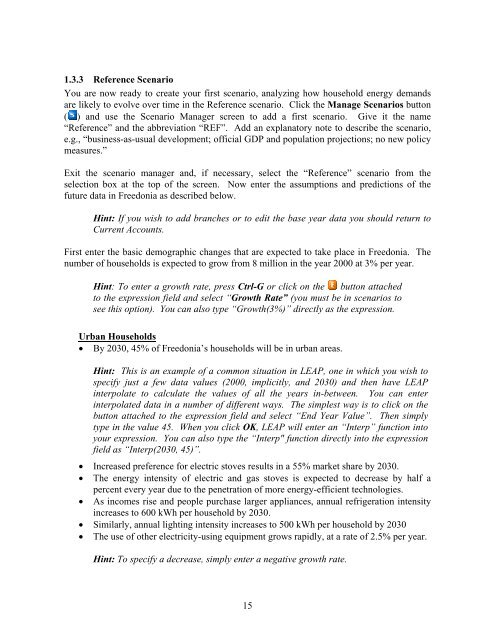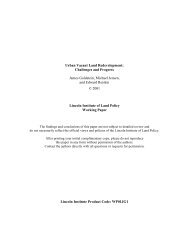training exercises - Tellus Institute
training exercises - Tellus Institute
training exercises - Tellus Institute
You also want an ePaper? Increase the reach of your titles
YUMPU automatically turns print PDFs into web optimized ePapers that Google loves.
1.3.3 Reference Scenario<br />
You are now ready to create your first scenario, analyzing how household energy demands<br />
are likely to evolve over time in the Reference scenario. Click the Manage Scenarios button<br />
( ) and use the Scenario Manager screen to add a first scenario. Give it the name<br />
“Reference” and the abbreviation “REF”. Add an explanatory note to describe the scenario,<br />
e.g., “business-as-usual development; official GDP and population projections; no new policy<br />
measures.”<br />
Exit the scenario manager and, if necessary, select the “Reference” scenario from the<br />
selection box at the top of the screen. Now enter the assumptions and predictions of the<br />
future data in Freedonia as described below.<br />
Hint: If you wish to add branches or to edit the base year data you should return to<br />
Current Accounts.<br />
First enter the basic demographic changes that are expected to take place in Freedonia. The<br />
number of households is expected to grow from 8 million in the year 2000 at 3% per year.<br />
Hint: To enter a growth rate, press Ctrl-G or click on the button attached<br />
to the expression field and select “Growth Rate” (you must be in scenarios to<br />
see this option). You can also type “Growth(3%)” directly as the expression.<br />
Urban Households<br />
• By 2030, 45% of Freedonia’s households will be in urban areas.<br />
Hint: This is an example of a common situation in LEAP, one in which you wish to<br />
specify just a few data values (2000, implicitly, and 2030) and then have LEAP<br />
interpolate to calculate the values of all the years in-between. You can enter<br />
interpolated data in a number of different ways. The simplest way is to click on the<br />
button attached to the expression field and select “End Year Value”. Then simply<br />
type in the value 45. When you click OK, LEAP will enter an “Interp” function into<br />
your expression. You can also type the “Interp" function directly into the expression<br />
field as “Interp(2030, 45)”.<br />
• Increased preference for electric stoves results in a 55% market share by 2030.<br />
• The energy intensity of electric and gas stoves is expected to decrease by half a<br />
percent every year due to the penetration of more energy-efficient technologies.<br />
• As incomes rise and people purchase larger appliances, annual refrigeration intensity<br />
increases to 600 kWh per household by 2030.<br />
• Similarly, annual lighting intensity increases to 500 kWh per household by 2030<br />
• The use of other electricity-using equipment grows rapidly, at a rate of 2.5% per year.<br />
Hint: To specify a decrease, simply enter a negative growth rate.<br />
15




